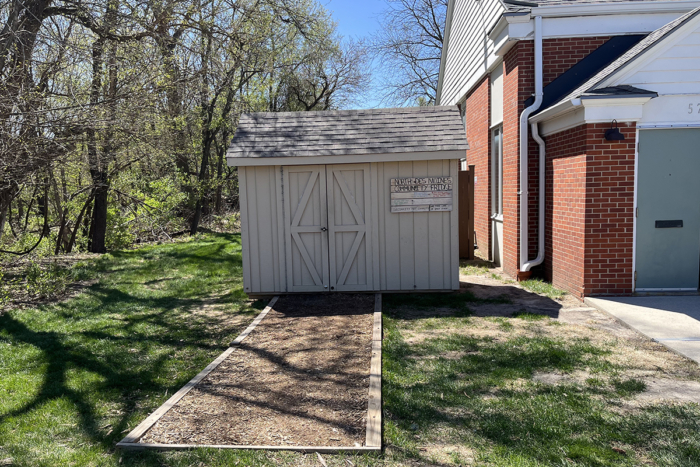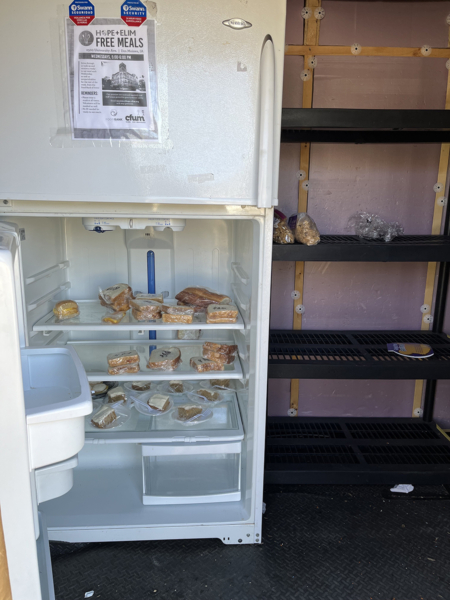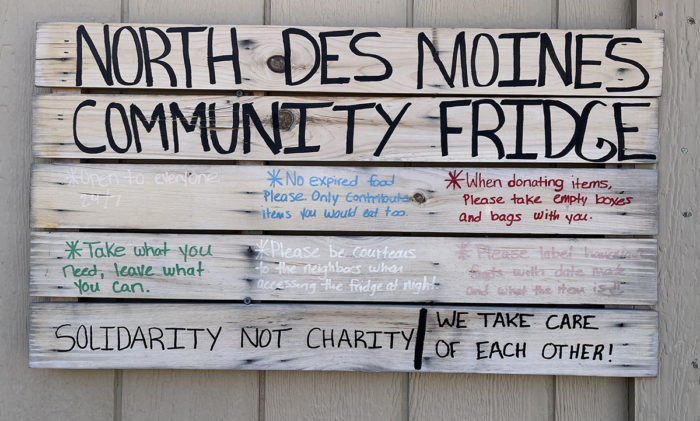Iowa church’s ‘community fridge’ becomes ministry hub connecting neighbors with neighborsPosted May 3, 2023 |
|

The North Des Moines Community Fridge, launched by North Des Moines Mutual Aid, has been housed in this shed at St. Andrew’s Episcopal Church since September 2021. Photo: Lizzie Gillman
[Episcopal News Service] Many Episcopal congregations run food pantries to collect and distribute food to hungry neighbors in need. The pantry at St. Andrew’s Episcopal Church in Des Moines, Iowa, is actually a shed, and it functions a bit different from the typical feeding ministry.
For starters, the shed at St. Andrew’s is open 24 hours a day, seven days a week, both for community members dropping off food and others looking to take home some of the donated items. More notably, the small structure that sits next to the church is equipped with a refrigerator, so visitors can receive perishable items like milk, eggs and produce, as well as nonperishable canned and dry goods.
Its official name is the North Des Moines Community Fridge, part of a network of about 45 similar locations around Iowa’s capital region. Since September 2021, when St. Andrew’s first provided the space for the shed and its refrigerator, the congregation has partnered with local organizations to interact with and support its surrounding community.

The refrigerator in the shed outside St. Andrew’s Episcopal Church is regularly stocked with a variety of perishable foods, along with pantry shelves for nonperishable foods. Photo: Lizzie Gillman
“It is an easily sustainable way to come together as a community to feed one another,” the Rev. Lizzie Gillman, St. Andrew’s priest-in-charge, told Episcopal News Service. “It requires many hands to be at work, and we as a congregation have come quickly to understand that we cannot do it all. It takes all of us.”
As she spoke with ENS by phone, she could see the shed through her office window and described in real time the hub of constant activity. Someone had pulled up in the church parking lot and opened the vehicle’s trunk to donate food. Another person, who had been waiting in a nearby car offered to help unload the trunk, placing some food items in the shed while selecting other items to take home.
“The shed is often empty,” Gillman said. “Food does not stay on the shelves long.”
The need is clear. Food Bank of Iowa, an affiliate of the national network Feeding America, reported serving a record of nearly 170,000 individuals in January, noting that food insecurity has been on the rise in Iowa. Last year, an average of 287,000 Iowans received assistance through the federal Supplemental Nutrition Assistance Program, or SNAP, formerly known as food stamps.
Then last month, Republican state lawmakers passed a bill making it more difficult for Iowans to receive SNAP benefits by expanding identity and financial eligibility checks. The bill passed over the objections of a group of more than 200 faith leaders, including at least 24 Episcopalians. “Feeding the poor is a universal value shared by all major faith traditions and all cultures,” they wrote in a letter to the state’s governor and legislative leaders, calling it a “moral, religious and humanitarian” issue.
Gillman said she has seen the need in her own community, on the northwest side of Des Moines. “Food insecurity has risen substantially over the last two years, and we are expecting it to rise again after the current legislation,” she told ENS.
The deployment of community refrigerators is a relatively new approach to feeding the hungry in the Des Moines region. A driving force in those efforts is the nonprofit Eat Greater Des Moines. It was founded 10 years ago to find new ways to combat hunger, with an increasing emphasis on “food rescue,” which aims to reduce the amount of food that ends up in the garbage.
To preserve that food for distribution to people who need it, Eat Greater Des Moines helped create the first community fridge in December 2020 through a partnership with Sweet Tooth Farm. Now the model has spread across four counties, with most of the refrigerators maintained indoors at apartment buildings, city halls, libraries and other public spaces.
“It doesn’t take much,” Executive Director Aubrey Alvarez told ENS. “The big part of it is just making sure everyone’s on board with it and know how it’s going to run.”
Alvarez’s organization has received grant money in the past to help purchase many of the refrigerators, which are little different from ones you would find in a home kitchen and cost about $800. Eat Greater Des Moines also offers to help community groups seek their own grants while developing a plan for maintaining community fridges.
The main benefit of the refrigerators is their accessibility. They “really are ‘take what you need, leave what you can,’” Alvarez said, adding, “they’re successful because of the community.”

The North Des Moines Community Fridge is maintained by the congregation at St. Andrew’s but is open 24 hours a day for anyone to come on their own to donate or pick up food. Photo: Lizzie Gillman
Local support has been critical to the success of the North Des Moines Community Fridge, which is one of only a handful of sites in Eat Greater Des Moines’ network that are located outdoors and accessible 24 hours a day.
The shed originally was established by a group called North Des Moines Mutual Aid and located on a residential property a few blocks away from St. Andrew’s. When the city officials warned it couldn’t be maintained at that location, St. Andrew’s offered space on its property, Gillman said.
By coincidence, the moving company chose a Sunday morning to transfer the shed to the church – right as the congregation was concluding an outdoor worship service.
“When the shed rolled up attached to the trailer of a pickup truck, we were just finishing Communion,” Gillman said. “It was almost as if it was a continuation of the worship service. … We were able to bless the congregation and the shed.”
The shed is just big enough to fit the refrigerator and some shelves for nonperishable food. St. Andrew’s had to add an external outlet to the church to plug in the appliance. The shed also was insulated so food wouldn’t freeze in the cold Iowa winters.
Eat Greater Des Moines recently committed to including St. Andrew’s in its weekly deliveries of donated food from commercial providers, though Gillman estimates 90% of the food in the shed is provided by church members and other nearby residents. Donations must follow some basic safely guidelines, including that it be packaged and labeled with expiration dates.
St. Andrews, with an average Sunday attendance of about 50, is in a low-income neighborhood on the edge of a business district, Gillman said. The North Des Moines Community Fridge is plainly visible from the sidewalk and bus stop. Apartment buildings and rental duplexes are plentiful, and many of the people who drop off and pick up food live nearby and come by foot.
“It has become a great way to become a better neighbor, by getting to know our neighbors in the community,” Gillman said. “We’re meeting a lot more people in the area because of the fridge.”
A sign on the shed reads “Solidarity not charity” and “We take care of each other!” Gilman underscored that maintaining this food ministry is ongoing commitment, not a one-time donation.
“We encourage people, if they want to donate to the fridge, to make it part of their spiritual practice for their daily living,” she said. For example, someone might choose to buy an extra half gallon of milk every Friday and bring it to the community refrigerator.
“The main goal is to be able to feed our community and to reduce barriers when it comes to getting access to food.”
– David Paulsen is a senior reporter and editor for Episcopal News Service. He can be reached at dpaulsen@episcopalchurch.org.

Social Menu